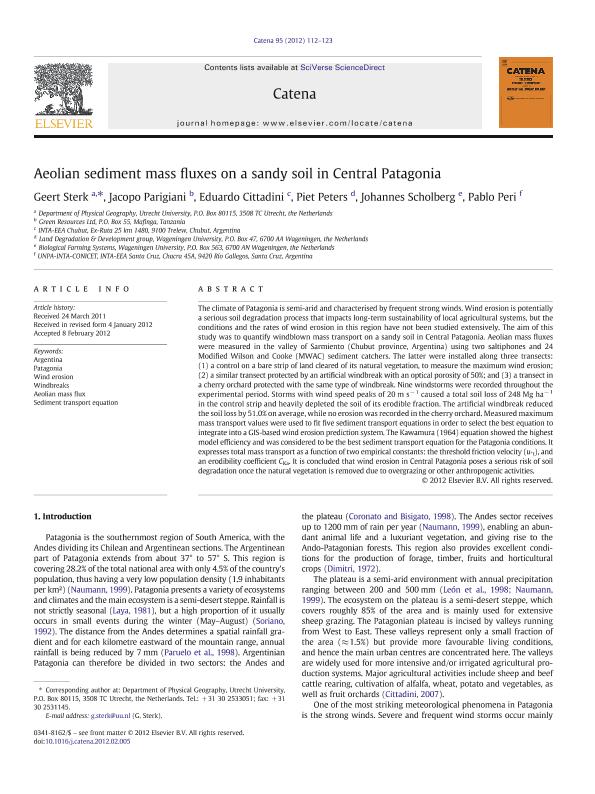Mostrar el registro sencillo del ítem
dc.contributor.author
Peri, Pablo Luis

dc.contributor.author
Parigiani, Jacopo
dc.contributor.author
Cittadini, Eduardo Daniel

dc.contributor.author
Peters, Piet
dc.contributor.author
Scholberg, Johannes
dc.contributor.author
Peri, Pablo Luis

dc.date.available
2023-05-09T11:14:02Z
dc.date.issued
2012-07
dc.identifier.citation
Peri, Pablo Luis; Parigiani, Jacopo; Cittadini, Eduardo Daniel; Peters, Piet; Scholberg, Johannes; et al.; Aeolian sediment mass fluxes on a sandy soil in Central Patagonia; Elsevier Science; Catena; 95; 7-2012; 112-123
dc.identifier.issn
0341-8162
dc.identifier.uri
http://hdl.handle.net/11336/196726
dc.description.abstract
The climate of Patagonia is semi-arid and characterized by frequent strong winds. Wind erosion is potentially a serious soil degradation process that impacts long-term sustainability of local agricultural systems, but the conditions and the rates of wind erosion in this region have not been studied extensively. The aim of this study was to quantify windblown mass transport on a sandy soil in Central Patagonia. Aeolian mass fluxes were measured in the valley of Sarmiento (Chubut province, Argentina) using two saltiphones and 24 Modified Wilson and Cooke (MWAC) sediment catchers. The latter were installed along three transects: (1) a control on a bare strip of land cleared of its natural vegetation, to measure the maximum wind erosion; (2) a similar transect protected by an artificial windbreak with an optical porosity of 50%; and (3) a transect in a cherry orchard protected with the same type of windbreak. Nine windstorms were recorded throughout the experimental period. Storms with wind speed peaks of 20 m s-1 caused a total soil loss of 248 ton ha-1 in the control strip and heavily depleted the soil of its erodible fraction. The artificial windbreak reduced the soil loss by 51.0% on average, while no erosion was recorded in the cherry orchard. Measured maximum mass transport values were used to fit five sediment transport equations in order to select the best equation to integrate into a GIS-based wind erosion prediction system. The Kawamura (1964) equation showed the highest model efficiency and was considered to be the best sediment transport equation for the Patagonia conditions. It expresses total mass transport as a function of two empirical constants: the threshold friction velocity ( ), and an erodibility coefficient . It is concluded that wind erosion in Central Patagonia poses a serious risk of soil degradation once the natural vegetation is removed due to overgrazing or other anthropogenic activities.
dc.format
application/pdf
dc.language.iso
eng
dc.publisher
Elsevier Science

dc.rights
info:eu-repo/semantics/openAccess
dc.rights.uri
https://creativecommons.org/licenses/by-nc-sa/2.5/ar/
dc.subject
AEOLIAN MASS FLUX
dc.subject
ARGENTINA
dc.subject
PATAGONIA
dc.subject
SEDIMENT TRANSPORT EQUATION
dc.subject
WIND EROSION
dc.subject
WINDBREAKS
dc.subject.classification
Agricultura

dc.subject.classification
Agricultura, Silvicultura y Pesca

dc.subject.classification
CIENCIAS AGRÍCOLAS

dc.title
Aeolian sediment mass fluxes on a sandy soil in Central Patagonia
dc.type
info:eu-repo/semantics/article
dc.type
info:ar-repo/semantics/artículo
dc.type
info:eu-repo/semantics/publishedVersion
dc.date.updated
2023-05-08T13:27:00Z
dc.journal.volume
95
dc.journal.pagination
112-123
dc.journal.pais
Países Bajos

dc.journal.ciudad
Amsterdam
dc.description.fil
Fil: Peri, Pablo Luis. University of Utrecht; Países Bajos. Consejo Nacional de Investigaciones Científicas y Técnicas; Argentina
dc.description.fil
Fil: Parigiani, Jacopo. No especifíca;
dc.description.fil
Fil: Cittadini, Eduardo Daniel. Instituto Nacional de Tecnología Agropecuaria. Centro Regional.patagonia Sur. Estación Experimental Agropecuaria Chubut; Argentina
dc.description.fil
Fil: Peters, Piet. University of Agriculture Wageningen; Países Bajos
dc.description.fil
Fil: Scholberg, Johannes. University of Agriculture Wageningen; Países Bajos
dc.description.fil
Fil: Peri, Pablo Luis. Instituto Nacional de Tecnología Agropecuaria. Centro Regional Patagonia Sur. Estación Experimental Agropecuaria Santa Cruz; Argentina. Consejo Nacional de Investigaciones Científicas y Técnicas; Argentina
dc.journal.title
Catena

dc.relation.alternativeid
info:eu-repo/semantics/altIdentifier/url/https://www.sciencedirect.com/science/article/pii/S0341816212000306
dc.relation.alternativeid
info:eu-repo/semantics/altIdentifier/doi/http://dx.doi.org/10.1016/j.catena.2012.02.005
Archivos asociados
